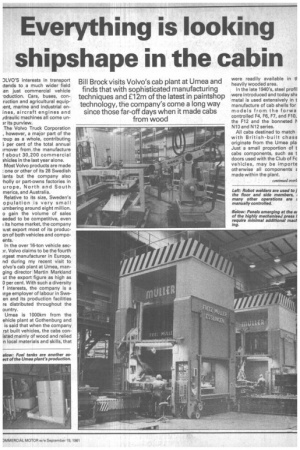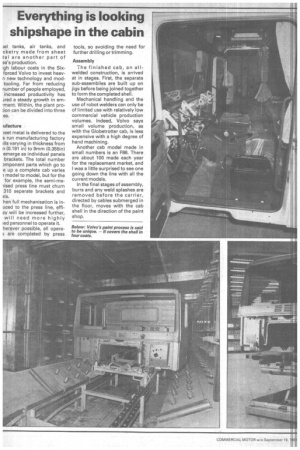Everything is looking shipshape in the cabin
Page 49

Page 50

Page 51

If you've noticed an error in this article please click here to report it so we can fix it.
Bill Brock visits Volvo's cab plant at Lima and finds that with sophisticated manufacturing techniques and £12m of the latest in paintshop technology, the company's come a long way since those far-off days when it made cabs from wood
DLVO'S interests in transport (tends to a much wider field an just commercial vehicle -oduction. Cars, buses, conruction and agricultural equiplent, marine and industrial enInes, aircraft engines and idraulic machines all come un.3r its purview.
The Volvo Truck Corporation , however, a major part of the -oup as a whole, contributing 5 per cent of the total annual inlayer from, the manufacture I about 30,200 commercial 3hicles in the last year alone. Most Volvo products are made : one or other of its 28 Swedish !ants but the company also 'holly or part-owns factories in urope, North and South merica, and Australia.
Relative to its size, Sweden's opulation is very small urnbering around eight million. o gain the volume of sales eeded to be competitive, even I its home market, the company ltd,st export most of its producon of both vehicles and compoents.
In the over 16-ton vehicle sec)r, Volvo claims to be the fourth irgest manufacturer in Europe, rid during my recent visit to oivo's cab plant at Umea, manging director Martin Markland ut the export figure as high as 0 per cent. With such a diversity f interests, the company is a irge employer of labour in Sween and its production facilities re distributed throughout the
011ntry.
Umea is 1000km from the ehicle plant at Gothenburg and is said that when the company rst built vehicles, the cabs conisted mainly of wood and relied n local materials and skills, that were readily available in II heavily wooded area.
In the late 1940's, steel profil were introduced and today shE metal is used extensively in t manufacture of cab shells for models from the forwa controlled F4, F6, F7, and F10, the F12 and the bonneted Is NTO and N12 series.
All cabs destined to match with British-built chess originate from the Umea pla Just a small proportion of t cabs components, such as t doors used with the Club of Fc vehicles, may be importe otherwise all components E. made within the plant.
lel tanks, air tanks, and cketry made from sheet tal are another part of aars production.
gh labour costs in the Sixforced Volvo to invest heav
n new technology and modtooling. Far from reducing number of people employed, increased productivity has ired a steady growth in em,ment. Within, the plant pro:ion can be divided into three es.
ufacture ieet metal is delivered to the s run manufacturing factory )1Is varying in thickness from
n (0.191 in) to 9mm (0.355in) emerge as individual panels brackets. The total number 3mponent parts which go to
e up a complete cab varies model to model, but for the for example, the semi-melised press line must churn 310 separate brackets and ?.1s.
hen full mechanisation is inuced to the press line, efficy will be increased further, will need more highly ied personnel to operate it. herever possible, all opera3 are completed by press
tools, so avoiding the need for further drilling or trimming.
Assembly The finished cab, an allwelded construction, is arrived at in stages. First, the separate sub-assemblies are built up on jigs before being joined together to iorm the completed shell.
Mechanical handling and the use of robot welders can only be of limited use with relatively low commercial vehicle production volumes. Indeed, Volvo says small volume production, as with the Globetrotter cab, is less expensive with a high degree of hand machining.
Another cab model made in small numbers is an F86. There are about 100 made each year for the replacement market, and I was a little surprised to see one going down the line with all the current models.
In the final stages of assembly, burrs and any weld splashes are removed before the carrier, directed by cables submerged in the floor, moves with the cab shell in the direction of the paint shop.
The recently commissioned paint shop at Umea incorporates the latest advancement in paint technology and cost El 2m. The process involves the application of coats of paint and intermediate baking. The first coat is applied by the cathodic electro dip process designed to ensure complete coverage and penetration of body members and cavities.
The painting is, however, only as good as the preparation, as no matter how thickly applied it will only stick where the surface is clean, and free from oil, dirt and grease.
Moving on a sled (what else in a country which is engulfed by snow for up to nine months each yeart the cab in the bare metal state is first submerged in a hot swirling alkaline degreasing solution before passing through a spray rinse and onto a brush wash which is said to remove even the most stubborn contaminate. Just to be on the safe side, however, the shell receives an alkaline spray once more before a zinc phosphate coat is applied. This is the base coat and will be the ultimate defence against stone chipping and scratching, while also serving to provide a good surface for the subsequent paint layers.
Draining and oven-drying remove any surplus fluid which might prevent the paint making contact during the next stage — the electric cathodic paint cycle.
Here, electrodes are attached to the body shell so that they move towards the metal surface and deposit the paint pigment. After passingthrough the cathodic bath, surplus paint not firmly attached to the metal surface is flushed away, preventing runs so that only a uniform thickness remains, thus minimising the need for subsequent rubbing-down.
After baking, a special sealing
compound is applied to all th joints to make them watertiglBitumen noise insulation par are located in strategic positior prior to the second coat of pail being added. This is a thick co rosion resistant layer applied I: using a warm electrostatic spa followed up once again by light bake.
Then a solvent-based sealE sprayed manually onto intern and external areas, provides good base for the final four gloss coat. Thixotropic fluid used on the underside of th cab, while rustproofing fluid introduced into cavities an joints.
Volvo attributes as much in portance to the improvements joint design as is placed on ft • benfits of the new paint syster where corrosion reduction is vital factor.
Trimming Before the cabs make ti 1,000km train ride to join ti chassis built to the south Gothenburg, each is trimmc and enclosed. This is clearly ti most labour-intensive operatic Even with a huge investme in mechanisation in conjunctic with the use of computers, would be difficult to simulate tl same high degree of flexibili afforded by the present systerr Here, the various cab types a fitted with all the standard iter included in a cab specificatio Windscreens, wipers, steerii columns, clutch, brake ar throttle assemblies, carpet panels and lining and handl are screwed, bolted and stu into place.
A few items such as seats al instrumentation allowing wid specification are added whi the cab is finally mounted on ti chassis,








































































